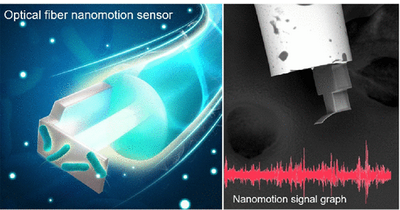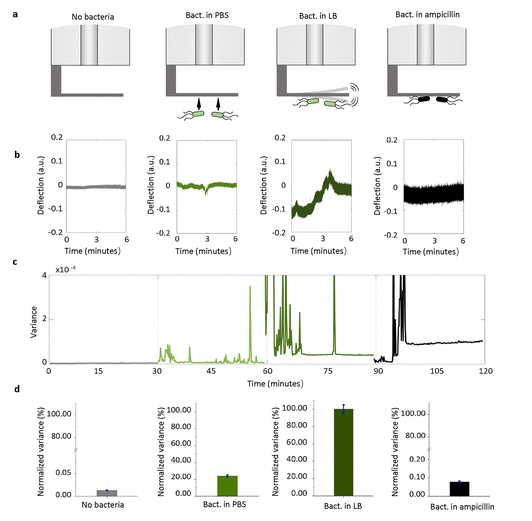Recently, the team led by Professor Wang Yiping from the School of Physics and Optoelectronic Engineering at Shenzhen University published a research paper titled "An Optical Fiber-Based Nanomotion Sensor for Rapid Antibiotic and Antifungal Susceptibility Tests" in the internationally renowned nanotechnology journal "Nano Letters" (SCI Q1, Nature Index journal, Impact Factor 10.8). The paper was published in the form of a cover article.
The paper reports a novel optical fiber-based ultra-sensitive nanomotion sensor, which utilizes femtosecond laser two-photon polymerization to 3D print microcantilevers at the end face of an optical fiber. This sensor is used for rapid antibiotic and antifungal susceptibility testing, significantly improving the testing speed, and achieving miniaturization and simplification of the testing device. Professor Liao Changrui from Shenzhen University and Dr. Zhou Jiangtao from École Polytechnique Fédérale de Lausanne (EPFL) are co-first authors, while Professor Wang Yiping from Shenzhen University, Professor Liao Changrui from Shenzhen University, Professor Sandor Kasas from EPFL, and Dr. Zhou Jiangtao from EPFL are co-corresponding authors.

Figure 1. Schematic diagram of a fiber-based nanomechanical vibration sensor
In recent years, the widespread misuse of antibiotics has led to widespread antimicrobial resistance, gradually becoming a global public health issue. One important method to limit its spread is through antimicrobial susceptibility testing to diagnose resistant bacteria. However, the main problems with current sensitivity testing methods are slow testing speeds and low degrees of parallel testing. Compared to traditional drug sensitivity tests that take several hours or even weeks, our optical fiber-based ultra-sensitive nanomotion sensor can achieve identification of resistant microorganisms within 1-3 hours, enabling the determination of the most appropriate drugs against specific organisms. Compared to the latest ultra-sensitive nanomotion sensors based on atomic force microscopy, our sensor achieves similar testing speeds but with higher degrees of miniaturization, showing great potential for future integration and parallel testing.
In this work, we propose an optical fiber-based nanomotion sensor, where the principle lies in the Fabry-Perot (FP) interferometer composed of the optical fiber end face and the cantilever beam. When the cantilever beam vibrates due to live microorganisms, it changes the optical path difference, resulting in dynamic interference changes. The core of its sensitive testing is the use of two-photon polymerization (2PP) technology to 3D print flexible and ultra-sensitive cantilever beams. We implement 2PP printing in the vertical direction to achieve thinner cantilevers, with a final thickness of about 1 micron. Additionally, the relatively low power of the femtosecond laser and the relatively fast scanning speed during polymerization result in a lower inherent stiffness related to the Young's modulus of the polymerized structure, thereby increasing the spring constant and detection sensitivity of the cantilever beams. The spring constant of the cantilever beams is reduced to approximately 0.3 N/m, which is comparable to commercially available silicon nitride AFM cantilevers. As a proof-of-concept prototype, we demonstrate the excellent performance of this fiber optic-based nanomotion sensor in real-time sensitivity testing of Escherichia coli and Candida albicans to antibiotics and antifungal drugs respectively, detecting nanoscale or sub-nanoscale cantilever vibrations induced by their metabolic activities. This nanomotion sensor strategy, with its advantages of rapid response and parallelization, may drive the technology to become the next generation of nanomotion sensors for large-scale and rapid antimicrobial susceptibility testing, as well as for other technological and biomedical applications.

Figure 2. Schematic diagram of laser processing for fiber-based nanomechanical vibration sensor

Figure 3. Nanoscale activity detection of ampicillin-sensitive Escherichia coli using fiber-optic nanomechanical vibration sensor
The research was supported by the National Excellent Youth Science Foundation and the Guangdong International Science and Technology Cooperation Project.
Original paper link: https://pubs.acs.org/doi/10.1021/acs.nanolett.3c03781?ref=pdf


![]() Add : No. 3688, Nanhai Avenue, Nanshan District, Shenzhen, Guangdong Province
Add : No. 3688, Nanhai Avenue, Nanshan District, Shenzhen, Guangdong Province ![]() Email : cpoe@szu.edu.cn
Email : cpoe@szu.edu.cn ![]() Phone: 0755-26538735
Phone: 0755-26538735 ![]() Fax : 0755-26538735
Fax : 0755-26538735